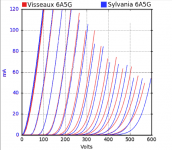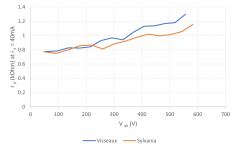Again? When was I wrong the first time?
Since energy can not be destroyed or created, yes it does. The air heats up from movement, the voice coil heats up from the current flow, the speaker wires also dissipate heat. and of course some of the energy is transformed into sound pressure. If you've ever run your subwoofers hard you'll notice the magnet and basket all get warm/hot, too.
I think it's you that's wrong. Please enlighten me.
Since energy can not be destroyed or created, yes it does. The air heats up from movement, the voice coil heats up from the current flow, the speaker wires also dissipate heat. and of course some of the energy is transformed into sound pressure. If you've ever run your subwoofers hard you'll notice the magnet and basket all get warm/hot, too.
I think it's you that's wrong. Please enlighten me.
Bring both images into photoshop (as 2 layers), remove the white from the top one, change the colour of the curves, collapse into a png and post it.
These lined up, if the 2 images don’t it is trickier.
dave
These lined up, if the 2 images don’t it is trickier.
dave
Less rollover on Sylvania curves
At 40mA plate current, the plate resistance (rp) of the Sylvania has a slower rate of change as Vak rises than the Visseaux. Put another way, the Sylvania's plate curves show less "rollover" with rising plate voltage. Looking at the plate curves, the Sylvania would be considered more linear.
At 40mA plate current, the plate resistance (rp) of the Sylvania has a slower rate of change as Vak rises than the Visseaux. Put another way, the Sylvania's plate curves show less "rollover" with rising plate voltage. Looking at the plate curves, the Sylvania would be considered more linear.
Attachments
Heat and signals are generated through different processes.
yes they are, but what is the point?
Why? Because with class A my amp draws less current under load then idle. Thus we must blast the music to save energy ... just something you see in Spice sims.
If you’re playing it loud enough to *see* the bias shift you ought to be pleased - this means it is generating 2nd harmonic distortion!
Nice Tektronix 576 in California on Ebay 193778636189Those curves are shot on a tektronix 576? That is the mercedes benz of curve tracers.
Do you have a link to information on this amp.A DIY design that was rather popular here in the 1950's used a single-ended output stage because it was simpler and cheaper and the output power was high enough for domestic use, according to its designer L. V. Viddeleer. Distortion was kept low by heavy feedback from the primary side of the output transformer - feedback from the secondary side was too hard to keep stable at high loop gains.
I have only built a SE amp so far (except for the guitar amp) but I look forward to building a PP class A some time to compare but I found the KT-88 SEUL to sound really nice on all types of music and at any volume level that I would ever use. My musical taste is broad including chamber music, large scale orchestral, opera, Big Band, Bluegrass, Gospel, Pipe Organ et.al. In all cases the tube amp sounded better than any of my solid state stuff. I expect that I will find that both types can sound great.
Yes, thanks to the online library of the Dutch historic radio association NVHR:Do you have a link to information on this amp.
Pages 449 ... 457 of the October 1954 issue of Radio Electronica, see
http://nvhrbiblio.nl/biblio/tijdschrift/Radio Electronica/1954/Radio Electronica 1954-10-OCR.pdf
Viddeleer discussed his tone control more thoroughly in the August 1953 issue, pages 29 ... 32 and 64, see http://nvhrbiblio.nl/biblio/tijdschrift/Radio Electronica/1953/Radio Electronica 1953-08-OCR.pdf and in the September 1953 issue, pages 19 ... 22 and 38, see http://nvhrbiblio.nl/biblio/tijdschrift/Radio Electronica/1953/Radio Electronica 1953-09-OCR.pdf
Last edited:
Thank you, I can't read Dutch but I can read the schematic. Fascinating. FB to the suppressor of the driver. Hmm.
As for the OP...
Today I learned that GNF and its effects depend on the speakers used.
I am taking a stab here, that SE vs PP also might sound very different depending on the the reflected impedance in the primary and speakers being used.
I can only speak for myself. I have speakers that are termed to be current driven. I have 2 amps, one 300B SE and the other an EL34 based PP.
PP is by far 100% more controlled and tight. SE is by far 100% more open and transparent.
The PP certainly has much tighter base and is much louder. That said, the SE 300B is certainly loud enough for me, more than enough base.
What do I listen to 99% of the time ? the 300B. A very loose analogy... The 300B is analogue, and the EL34PP is Digital.
Its a fantastic example of a horrible analogy but does get my meaning across... that is if you know what I mean LOL...
Edit....
So, I just read through some of the replys...
Planet10 had a 1000 times better reply (as expected!)
Today I learned that GNF and its effects depend on the speakers used.
I am taking a stab here, that SE vs PP also might sound very different depending on the the reflected impedance in the primary and speakers being used.
I can only speak for myself. I have speakers that are termed to be current driven. I have 2 amps, one 300B SE and the other an EL34 based PP.
PP is by far 100% more controlled and tight. SE is by far 100% more open and transparent.
The PP certainly has much tighter base and is much louder. That said, the SE 300B is certainly loud enough for me, more than enough base.
What do I listen to 99% of the time ? the 300B. A very loose analogy... The 300B is analogue, and the EL34PP is Digital.
Its a fantastic example of a horrible analogy but does get my meaning across... that is if you know what I mean LOL...
Edit....
So, I just read through some of the replys...
Planet10 had a 1000 times better reply (as expected!)
Last edited:
Only up to page 4 of this thread, but andyjevans and scottjoplin get the "Most learned and respectful" award of the year. Just masterful is the exchange.. Kudos!
- Home
- Amplifiers
- Tubes / Valves
- Why has single ended output become popular

